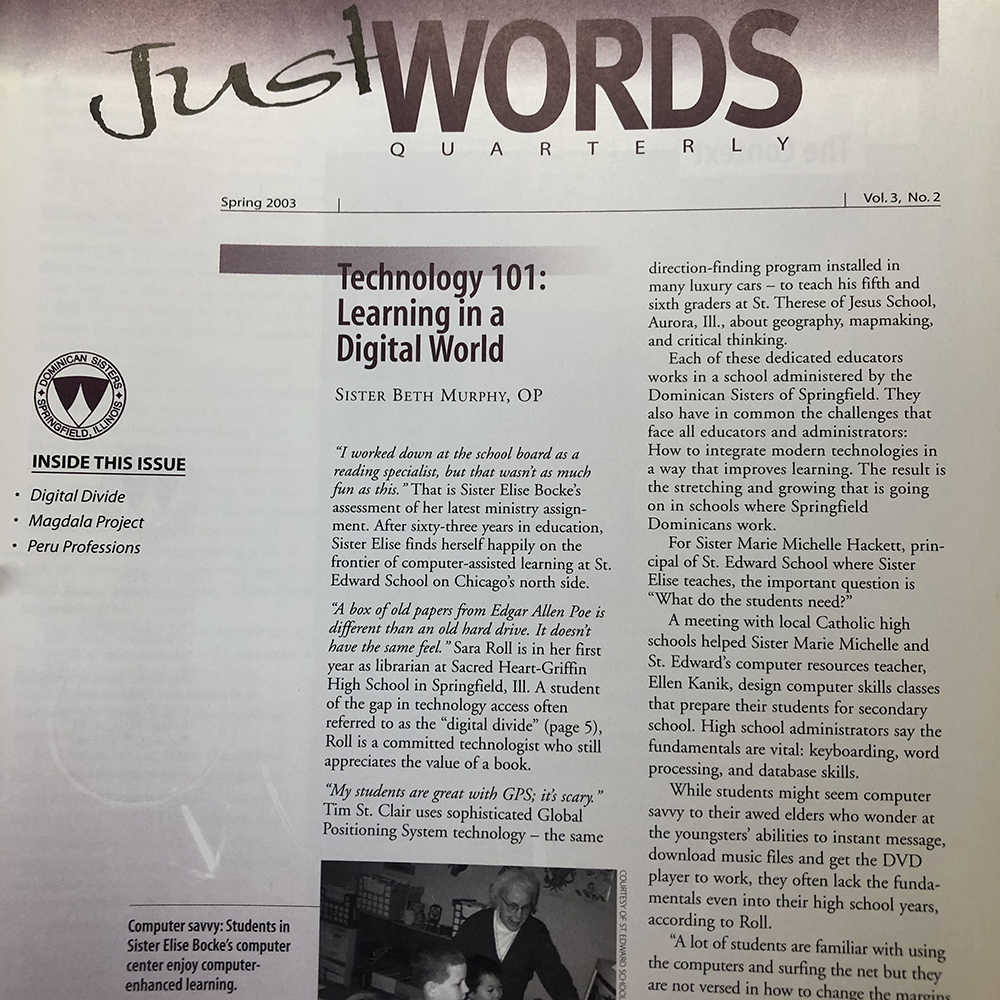
“I worked down at the school board as a reading specialist, but that wasn’t as much fun as this.” That is Sister Elise Bocke’s assessment of her latest ministry assignment. After sixty-three years in education, Sister Elise finds herself happily on the frontier of computer-assisted learning at St. Edward School on Chicago’s north side.
“A box of old papers from Edgar Allen Poe is different than an old hard drive. It doesn’t have the same feel.” Sara Roll is in her first year as librarian at Sacred Heart-Griffin High School in Springfield, Ill. A student of the gap in technology access often referred to as the “digital divide,” Roll is a committed technologist who still appreciates the value of a book.
GPS for kids?
“My students are great with GPS; it’s scary.” Tim St. Clair uses sophisticated Global Positioning System Technology—the same direction-finding program installed in many luxury cars—to teach his fifth and sixth graders at St. Therese of Jesus School, Aurora, Ill., about geography, map making, and critical thinking.
Each of these dedicated educators works in a school administered by the Dominican Sisters of Springfield. They also have in common the challenges that face all educators and administrators: How to integrate modern technologies in a way that improves learning. The result is the stretching and growing that is going on in schools where Springfield Dominicans work.
For Sister Marie Michelle Hackett, principal of St. Edward School where Sister Elise teaches, the important question is “What do the students need?”
A meeting with local Catholic high schools helped Sister Marie Michelle and St. Edward’s computer resources teacher, Ellen Kanik, design computer skills classes that prepare their students for secondary school. High school administrators say the fundamentals are vital: keyboarding, word processing, and database skills.
Computing fundamentals
While students might seem computer savvy to their awed elders who wonder at the youngsters’ abilities to instant message, download music files, and get the DVD player to work, they often lack the fundamentals even into their high school years, according to Roll.
“A lot of students are familiar with using the computers and surfing the net, but they are not versed in how to change the margins in a word-processing document,” Roll says. “They don’t know how to use a search engine to the fullest extent.” It is these fundamentals that are the foundation of effective and efficient computer use in schools.
Computers are tools for teachers, too. Sister Elise has skills diverse enough to assist a broad range of students in the school. One period she may have three gifted first graders taking a literacy assessment test; the next it might be a child who has recently immigrated from Korea, the Philippines, or Brazil. She says the broad range of computer software available to her makes her work more efficient, more effective, and more rewarding for the students. The computers allow her to better track student progress. They have also taken on the repetitive tasks of drill, she says, leaving her with more time to assess the students’ needs and customize their learning program.
While one might think that parents choose a school for their children based on the school’s ability to keep up with the joneses, technologically speaking, Sister Marie Michelle’s experience doesn’t bear that out. She says that frequently parents ask questions about technology, but their real concern is the quality of the interaction between the students and the teachers. “They don’t want them spending a lot of time on (computers) because they spend so much time on them at home,” Sister Marie Michelle says.
The ultimate goal for the integration of computer technologies into the classroom is for them to become tools that assist teachers in teaching and students in learning, no matter what the discipline, according to Roll.
Thinking and synthesizing
St. Therese School, where the student body comes from economically disadvantaged homes, might not be the place you’d expect to find this kind of integrated and engaged learning, but that is just what science teacher Tim St. Clair is doing. Last year St. Clair participated in an intensive seminar sponsored by North Central College. The seminar taught teachers how to use GPS and Global Information Systems (GIS) to sharpen the students’ critical thinking and synthesizing skills. Last fall his students used the technology to map and measure trees in a nearby forest preserve. This spring they will return to the forest, and using a map they created, locate and measure the trees again to test their hypotheses about which tree were likely to thrive.
The St. Therese students are themselves thriving with this learning model, according to St. Clair. “They are more hands on,” he says. They are “not just reading, but creating, improving their thinking skills, synthesizing, and creating hypotheses.”
Ss. Peter and Paul School in Cary, Ill., may have the optimal technology situation of any Springfield Dominican-administered schools. Three years ago, the parish received two large anonymous gifts that have enabled them to make every classroom a “smart classroom.” Twenty-four rooms each have a networked computer station and multi-media projector that make it possible for teachers and students to use the technology as a tool for learning. While the equipment is a great gift, principal Sister Katrina Lamkin says it is only as effective as those who use it.
Ss. Peter and Paul began integrating technology as a tool in 1993 when it opened its first computer lab. The gift that purchased the new technology recently also paid for a week-long teacher training session last fall, so that the teachers would be ready for their students on the first day of class.
What difference does the technology make? “Never has there been a day since 1993,” Sister Katrina says, “that the students are not excited about learning. There is never a motivation problem.”
First published in JUST Words, Vol. 3, No. 2, Spring 2003.

